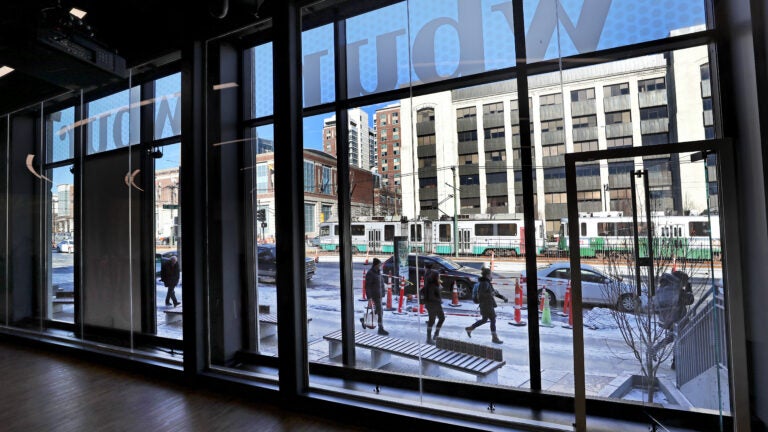Quiet! Tips for soundproofing your home or rental
There are extensive things you can do to block the noise and some relatively inexpensive steps you can take.

Working from home may mean fewer interruptions from chatty coworkers, but there are other distractions to contend with. From sibling shouting matches and yapping dogs to the rumble of construction trucks and the unholy racket of leaf blowers, unwanted noises can rudely interrupt Zoom meetings or shatter an otherwise productive day at the home office.
Steven Drago, account manager at New England Soundproofing in Easton, said he’s never had so many residential clients than in the past year and a half. Whether it’s to silence the squawk of a neighbor’s bird or a blaring television set, Drago said, “We have seen a major increase in calls and projects for homes in general, and for condos especially.’’ (Another common reason people call the soundproofers: “The moans of the humans next door,’’ he said. “That actually happens a lot more than you know.’’)
Before embarking on a noise-cancellation crusade, it’s important to keep realistic expectations. “You will not completely soundproof your environment without professional help and spending an awful lot of money,’’ said Susan Rogers, director of the Music Perception and Cognition Laboratory at Berklee College of Music. However, she said, there are steps homeowners can take to reduce or soften nuisance sounds, ranging from intensive renovations to inexpensive interior design hacks.
New England Soundproofing specializes in the former. Drago said the company’s complete, turnkey service costs roughly $90 to $95 per square foot, though the company also sells soundproofing materials and will coach ambitious do-it-yourselfers and other contractors through the installation.
Since most noise complaints concern upstairs neighbors, Drago said, they start by removing the existing ceiling sheetrock and fiberglass insulation and installing high-absorption cotton insulation. “Cotton is a great absorber for sound,’’ he said, in addition to offering thermal protection. “We then install our sound barrier,’’ Drago said, which is a thick layer of high-density vinyl. “We’re slowing down the noise that’s in the ceiling with the acoustical insulation, and we’re blocking that noise with the sound barrier.’’
After completely sealing up that portion of the ceiling — even removing the lights — Drago’s crew installs the first of two layers of -inch blueboard using a clip-and-channel system, essentially suspending the sheetrock below the ceiling and about -inch away from the walls. This process drops the ceiling by about 2 inches, Drago said, but isolates the sheetrock from footfalls and other vibrations above. “When sheetrock vibrates, it becomes a speaker,’’ he said.
Next comes a layer of Green Glue Noiseproofing Compound — a viscoelastic material that, when applied between two rigid surfaces, converts sound energy into a small amount of friction heat. That’s followed by a second layer of blueboard, acoustical caulking around the perimeter, and low-profile recessed lights that reduce sound penetration.
Walls typically get a similar treatment, Drago said, though the company offers a faster and less invasive option, too. “We manufacture a panel system that mounts to your wall, covers it floor to ceiling,’’ he said. While not quite as effective, installing custom-sized panels over the existing wall still creates a denser, more sound-absorbent surface and doesn’t require demolition.
There are some less expensive, do-it-yourself techniques to try as well, Rogers said — but it helps to understand how sound waves behave and which ones are more distracting than others.
Low-frequency noises — whether they be thumping bass lines or the rumble of furniture above — are the hardest to contain, she said.
“Low frequencies are going to behave like water: They’re going to go wherever they can. They’re going to permeate doors and walls and windows,’’ Rogers said.
High frequencies, on the other hand, are easier to disrupt. “They’ve got weak energy because they’re vibrating so quickly,’’ she explained.
But to dampen the most distracting sounds in your office, focus on the mid-range frequencies, Rogers said, which include the siren call of the human voice. “The human auditory path evolved to be especially sensitive to human speech — that’s by far the most important sound in our environment,’’ she said, and the reason our outer ear is shaped the way it is. “It’s designed to pick up and amplify those mid-range frequencies between one and four kilohertz.’’
In the average room, mid-frequency noises will start to pile up, bouncing around and reflecting off the parallel surfaces of the floor and ceiling, Rogers said. But there are some simple, inexpensive materials and techniques that can absorb high- and mid-range frequencies, starting with fabrics and books.
“Rugs will definitely help, because otherwise, if you don’t have rugs on the floor, those mid-frequencies are just going to bounce right off the hard surface of the floor,’’ Rogers said. “Acousticians use a cheap trick of putting up bookshelves or bookcases.’’ If you don’t have an extensive library, you can buy books in bulk from a thrift store or yard sale, line your office walls with bookcases, and turn the spines inward, toward the walls, so that the pages face out. “Those leaves of those pages do a nice job of absorbing the mid-frequencies,’’ Rogers said.
Shelves of books facing the proper direction will help, too — not just because of their bulk, but because their uneven heights and thicknesses will break up sound waves, creating a prettier, softer sound. It’s similar to the effect of those milky-hued light diffusers professional photographers use. “What they’re trying to do is break up the pattern of the lightwave, so it’s soft and diffuse rather than a beam of light shining right on your face,’’ Rogers said. “Books do the same thing for those mid- and high frequencies of sound waves: They diffuse it, so at least the sound that you’re dealing with in your room is prettier and has a nicer tone to it.’’
Another old hack used in home recording studios, Rogers said, is to put cardboard egg cartons on the wall. “Those little cardboard pockets will absorb a lot of the mid-frequencies,’’ she said. But for about $100, you can take a more professional-grade approach and purchase a pack of Owens Corning 703 acoustic panels. The panels (2-inch-thick ones that are 4 feet by 2 feet) are lightweight and easy to attach to a wall, but they’re not much to look at — so Rogers recommended picking up fun fabric and gluing or stapling it onto the panels. “That’ll do a great job of absorbing a lot of those mid-frequencies,’’ she said.
Sound also will sneak through cracks and gaps, so simple energy-efficient updates, such as installing door sweeps, weatherstripping, and storm windows, will help keep out unwanted drafts as well as noises. But sealing yourself shut isn’t always possible — or preferable, if the weather is nice. This summer, Rogers was on deadline, with a book manuscript due to her publisher. But her open Mass. Ave. window seemed to invite in every possible aural distraction — voices in the alleyway, a neighbor’s barking dog — making it hard to focus.
Rogers doesn’t like to wear earplugs or noise-canceling headphones — two last-resort options for hyperlocal soundproofing. Instead, she turned to another last-ditch sound-blocker: eight-hour videos of the ocean on YouTube.
The roar of the ocean won’t stop unwanted noises from intruding into your office, but it can keep them from breaking your focus. Because ocean waves contain a full spectrum of sound waves, they’re capable of masking a variety of noises. “White light is similar to white noise; it’s got all the frequencies in there,’’ Rogers said. “That broadband signal of the ocean, the gentle ocean waves crashing on the beach, will cover the spectrum, from the lows to the mids to the highs, and provide a noise floor.’’
Plus, white noise is blessedly boring. “When our brain has nothing to pay attention to … we just tune it out if it’s not changing,’’ she said. “So give yourself a source of just passive, boring noise, and that will help suppress interference that’s coming into your room.’’
But no, that doesn’t mean your next office Zoom call will soundproof itself.
Jon Gorey blogs about homes at HouseandHammer.com. Send comments to [email protected]. Follow him on Twitter at @jongorey. Subscribe to our free real estate newsletter at pages.email.bostonglobe.com/AddressSignUp. Follow us on Facebook, LinkedIn, Instagram, and Twitter @globehomes.
Correction: Because of an editing error, a previous version of this story gave an incorrect measurement for low-frequency noise. The unit of measurement is hertz. The Globe regrets the error.








Conversation
This discussion has ended. Please join elsewhere on Boston.com